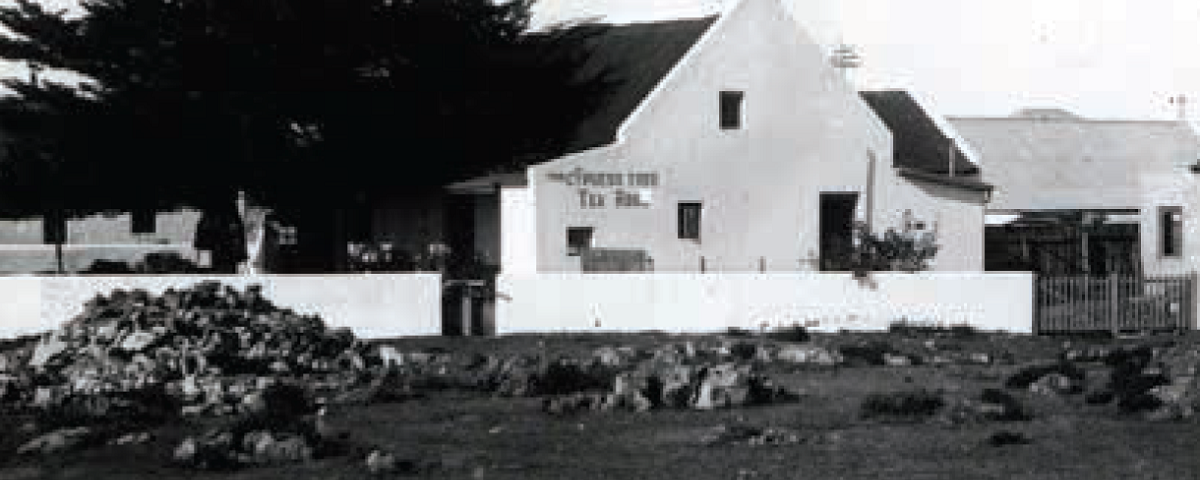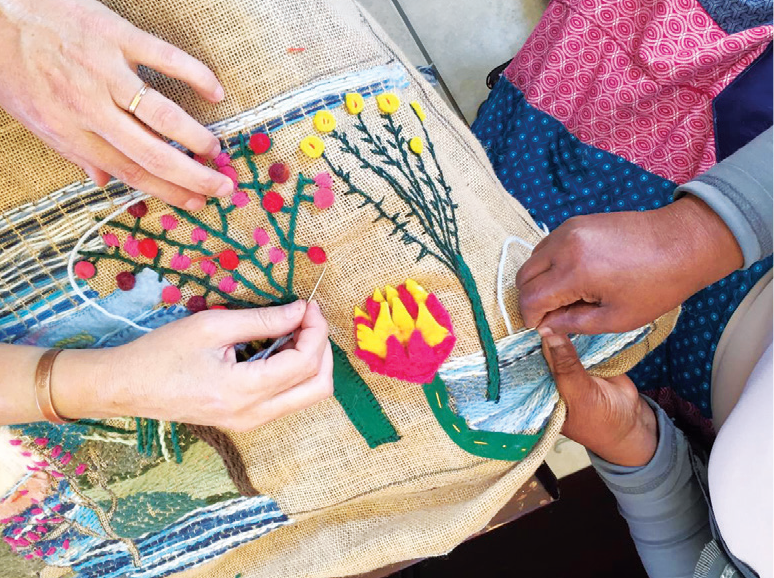
Stitching communities together – A Hermanus History Society Project
December 27, 2018
MY SECRET VENICE
January 10, 2019CYPRESS TREE TEA GARDENS This is one of the few establishments where a building from the 1920s still stands and is still used for the same function. However, the building did not begin life as a café or tea room. Rather, it was closely related to the only productive activity in the town – fishing.
In the 1870s, a sailor named Jean-Louis built a structure near Visbaai (as the Old Harbour was known) and started a boat-building and boat-repair business. It was located where the Burgundy Restaurant now is. In about 1902, John (nicknamed Swede) planted a cypress tree in the small garden around his home and business.
In 1928, the property was bought by Miss Ethel Rubery, who had been a Voluntary Aid Detachment nurse in WWI serving in Egypt and who worked tirelessly for St Dunstan’s during WWII. She converted the cottage into a tea garden, under the name Cypress Tree Tea Gardens. It was a popular venue and continued under that name until after WWII.
We know that Brian McFarlane briefly managed the Cypress Tree Tea Gardens before he started the abalone canning factory at the New Harbour in 1954. At one point, the building almost disappeared. S J du Toit describes events as follows:
In 1968, the building was nearly lost to the greed of developers. When villagers heard that plans were afoot to demolish the old building… concerned citizens made every attempt to save the building. By the generosity of Jack and Pamela Swart, who provisionally bought it, a breath-space was created, delaying demolition.
In 1979 the building was acquired by Tim Hamilton-Russell who refitted it and used it as a tasting venue for his wines. He gave it the name of The Burgundy. In the 1980s it became a restaurant and has remained so until today. Under the expert hand of Chef Rudolf van der Berg and his team, The Burgundy has become a top tourist attraction due to its location and reputation for excellent food. Parts of the building are classified as a national monument.
BALCONY TEA ROOM For several decades, the Balcony Tea Room operated on the first floor of the Balcony Building (numbers 58-62 Main Road), that is today mainly associated with The Factory Shop.
The Balcony Building was constructed in the early 1900s, perhaps as early as 1906. The work was done by Robert Walter MacFarlane (1874 - 1955), son of one of the original settlers, who was also named Walter MacFarlane. Several of the men in the family were named Walter, so Robert Walter was generally known as Wattie. The Balcony Building was almost certainly the largest commercial building in Hermanus at the time it was built.
It is not clear when the Tea Room started business in the Balcony Building, but Joey Luyt records that it was operating by 1930 and was famous for its ‘mixed grills’, available after the regular dances and the cinema show ended each evening.
Peter van Dyk told S J du Toit that in the 1950s, We loved the Balcony Tearoom where we could sit on the balcony and see the street panorama below. This was the place the young people congregated, chatting and listening to the jukebox. On the right side in the big hall was a roller-skating rink, later converted into offices… The Balcony was the main hall in the village. The BESL (British Empire Service League) held their annual Christmas function in the roller-skating hall. The Grobbelaar Hall was not yet built… Another regular user of the hall next to the Tea Room was the annual ‘wildflower show’. Long-standing Hermanus resident Nancy Okes recalls the event in the 1920s:
…Three long sets of trestle tables, covered with starched white cloths stretched down the room. On these were vases and pots and bowls of fynbos… Onlookers spoke in hushed tones. The scent was overwhelming…
Since starting this research, I have made contact with Mrs Sheila Addison whose family owned the Tea Room in the second half of the 20th century. Watch out for more details of the Balcony Tea Room.
KRAAL ROCK TEA GARDENS Kraal Rock is one of the lesser-known sites in Hermanus history; yet it plays a role in many stories. It is located on the Main Road, roughly opposite the Golf Course, and is most easily recognized from Main Road by a large, grassy parking area, and the name ‘Kraal Rock’ painted on the wall of the house on your left coming from Voelklip.
Historically, the name is said to derive from the many unfortunate people suffering from leprosy who were confined to a leper station in the Hemel-en-Aarde Valley from the early 19th century. Occasionally they were allowed to leave the station and move over the mountain to the north of Hermanus and come down to the sea. The famous Dr James Barry believed their health might improve if they spent some time close to or in the ocean. They brought their cattle with them, and these were held in a kraal where the open/parking space is now.
There was excellent fishing off the rocks at this point, and so the place came to be known to fi shermen as ‘Kraal Rock’. It was considered the best fishing spot for kabeljou and was crowded with anglers when the fish was ‘running’.
In the late 1920s, a tearoom was opened there to cater for the fi shermen and travellers from the eastern suburbs of Hermanus. The tearoom specialised in homemade scones with jam and cream. In the 1930s the business was managed by Mr and Mrs Ling, a Scottish couple who fl ew the Scottish fl ag every day. The bus between the Marine and Riviera Hotels stopped there twice a day in season. Ella Gordon brought her cart to a halt for tea whenever she was returning from Hermanus to her cottage in Voelklip.
Kraal Rock is a windy spot, so the Lings built structures of bamboo in the garden to protect customers. Mr Ling has another claim to fame. He had made deliveries one day in Cape Town and concerned at driving an empty lorry to Hermanus, he decided to buy a considerable quantity of saplings he had seen, for resale in Hermanus. These turned out to be Norfolk Island pine trees. He sold these for 1 shilling and sixpence each. They sold well, and now there are hundreds of the trees in Hermanus.
In the 1870s, a sailor named Jean-Louis built a structure near Visbaai (as the Old Harbour was known) and started a boat-building and boat-repair business. It was located where the Burgundy Restaurant now is. In about 1902, John (nicknamed Swede) planted a cypress tree in the small garden around his home and business.
In 1928, the property was bought by Miss Ethel Rubery, who had been a Voluntary Aid Detachment nurse in WWI serving in Egypt and who worked tirelessly for St Dunstan’s during WWII. She converted the cottage into a tea garden, under the name Cypress Tree Tea Gardens. It was a popular venue and continued under that name until after WWII.
We know that Brian McFarlane briefly managed the Cypress Tree Tea Gardens before he started the abalone canning factory at the New Harbour in 1954. At one point, the building almost disappeared. S J du Toit describes events as follows:
In 1968, the building was nearly lost to the greed of developers. When villagers heard that plans were afoot to demolish the old building… concerned citizens made every attempt to save the building. By the generosity of Jack and Pamela Swart, who provisionally bought it, a breath-space was created, delaying demolition.
In 1979 the building was acquired by Tim Hamilton-Russell who refitted it and used it as a tasting venue for his wines. He gave it the name of The Burgundy. In the 1980s it became a restaurant and has remained so until today. Under the expert hand of Chef Rudolf van der Berg and his team, The Burgundy has become a top tourist attraction due to its location and reputation for excellent food. Parts of the building are classified as a national monument.
BALCONY TEA ROOM For several decades, the Balcony Tea Room operated on the first floor of the Balcony Building (numbers 58-62 Main Road), that is today mainly associated with The Factory Shop.
The Balcony Building was constructed in the early 1900s, perhaps as early as 1906. The work was done by Robert Walter MacFarlane (1874 - 1955), son of one of the original settlers, who was also named Walter MacFarlane. Several of the men in the family were named Walter, so Robert Walter was generally known as Wattie. The Balcony Building was almost certainly the largest commercial building in Hermanus at the time it was built.
It is not clear when the Tea Room started business in the Balcony Building, but Joey Luyt records that it was operating by 1930 and was famous for its ‘mixed grills’, available after the regular dances and the cinema show ended each evening.
Peter van Dyk told S J du Toit that in the 1950s, We loved the Balcony Tearoom where we could sit on the balcony and see the street panorama below. This was the place the young people congregated, chatting and listening to the jukebox. On the right side in the big hall was a roller-skating rink, later converted into offices… The Balcony was the main hall in the village. The BESL (British Empire Service League) held their annual Christmas function in the roller-skating hall. The Grobbelaar Hall was not yet built… Another regular user of the hall next to the Tea Room was the annual ‘wildflower show’. Long-standing Hermanus resident Nancy Okes recalls the event in the 1920s:
…Three long sets of trestle tables, covered with starched white cloths stretched down the room. On these were vases and pots and bowls of fynbos… Onlookers spoke in hushed tones. The scent was overwhelming…
Since starting this research, I have made contact with Mrs Sheila Addison whose family owned the Tea Room in the second half of the 20th century. Watch out for more details of the Balcony Tea Room.
KRAAL ROCK TEA GARDENS Kraal Rock is one of the lesser-known sites in Hermanus history; yet it plays a role in many stories. It is located on the Main Road, roughly opposite the Golf Course, and is most easily recognized from Main Road by a large, grassy parking area, and the name ‘Kraal Rock’ painted on the wall of the house on your left coming from Voelklip.
Historically, the name is said to derive from the many unfortunate people suffering from leprosy who were confined to a leper station in the Hemel-en-Aarde Valley from the early 19th century. Occasionally they were allowed to leave the station and move over the mountain to the north of Hermanus and come down to the sea. The famous Dr James Barry believed their health might improve if they spent some time close to or in the ocean. They brought their cattle with them, and these were held in a kraal where the open/parking space is now.
There was excellent fishing off the rocks at this point, and so the place came to be known to fi shermen as ‘Kraal Rock’. It was considered the best fishing spot for kabeljou and was crowded with anglers when the fish was ‘running’.
In the late 1920s, a tearoom was opened there to cater for the fi shermen and travellers from the eastern suburbs of Hermanus. The tearoom specialised in homemade scones with jam and cream. In the 1930s the business was managed by Mr and Mrs Ling, a Scottish couple who fl ew the Scottish fl ag every day. The bus between the Marine and Riviera Hotels stopped there twice a day in season. Ella Gordon brought her cart to a halt for tea whenever she was returning from Hermanus to her cottage in Voelklip.
Kraal Rock is a windy spot, so the Lings built structures of bamboo in the garden to protect customers. Mr Ling has another claim to fame. He had made deliveries one day in Cape Town and concerned at driving an empty lorry to Hermanus, he decided to buy a considerable quantity of saplings he had seen, for resale in Hermanus. These turned out to be Norfolk Island pine trees. He sold these for 1 shilling and sixpence each. They sold well, and now there are hundreds of the trees in Hermanus.
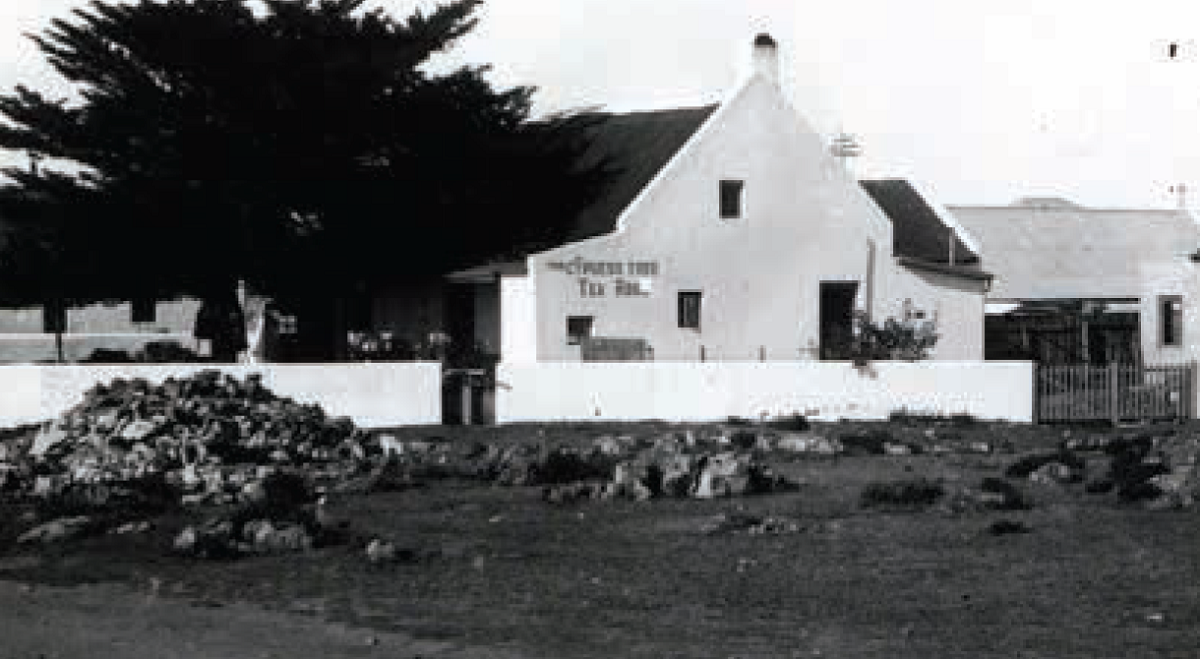
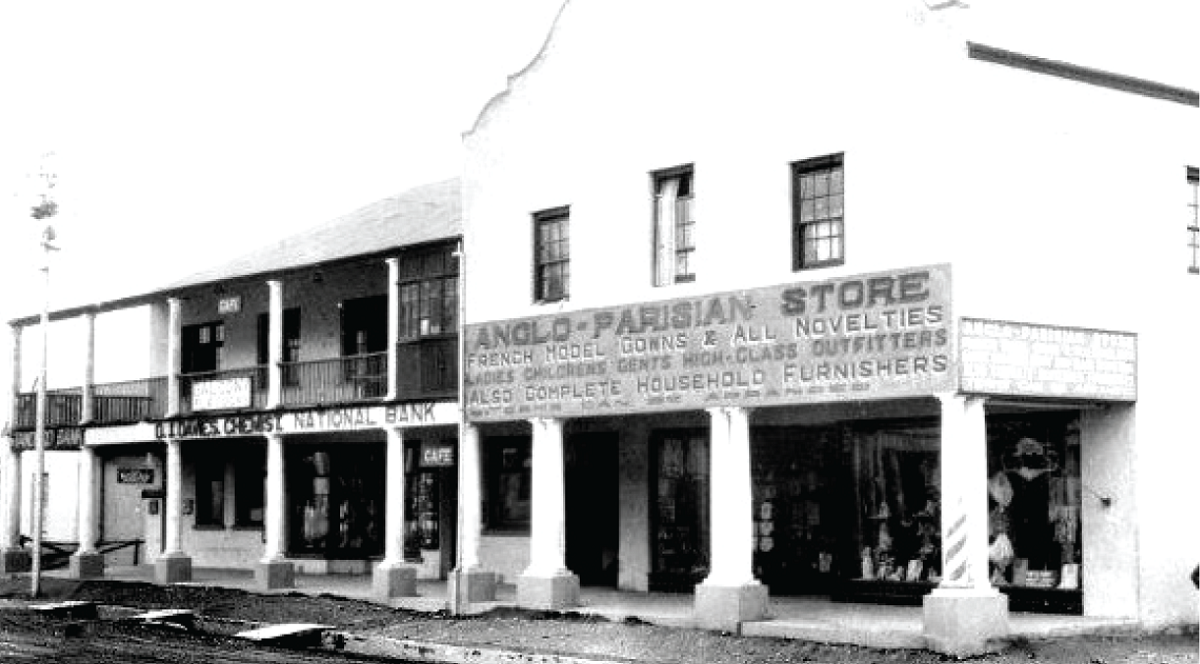
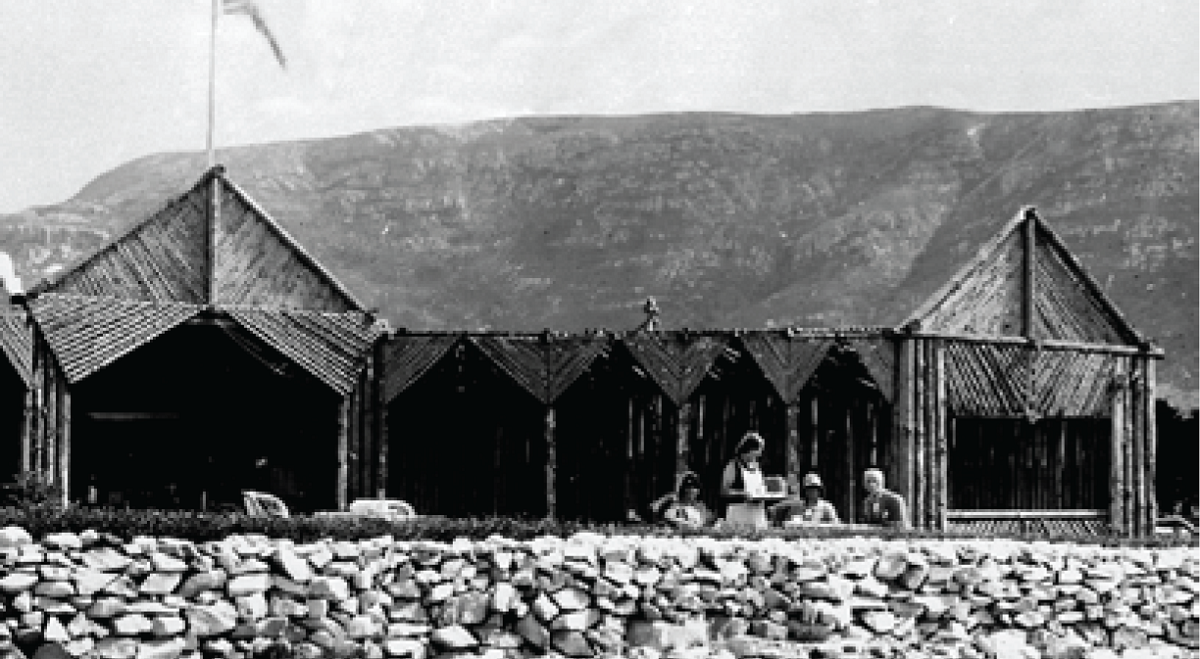
In his new series on the history of tea rooms, cafes and restaurants in Hermanus, DR ROBIN LEE of the Hermanus History Society takes a look at three tearooms that were popular in their day among locals and visitors.

